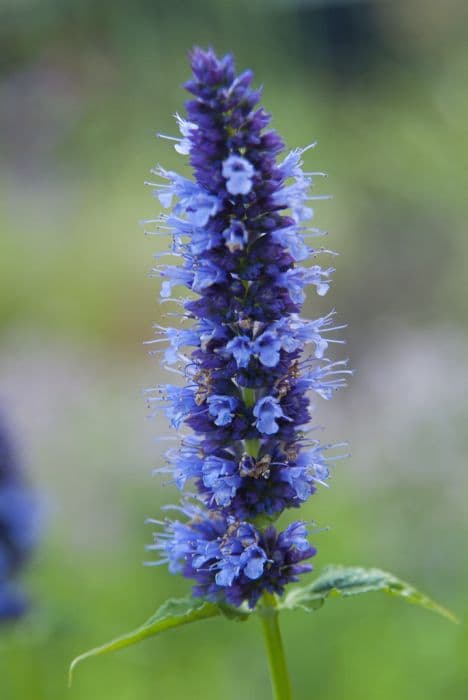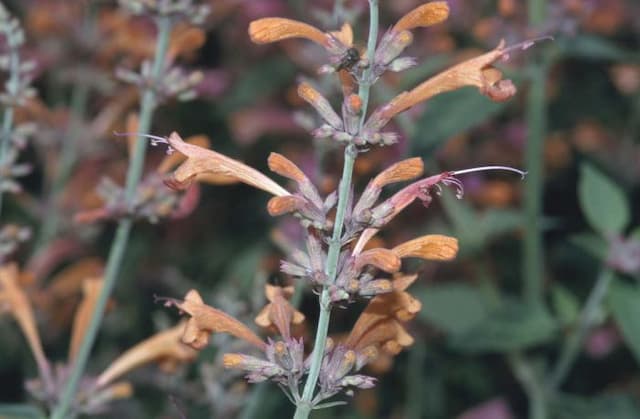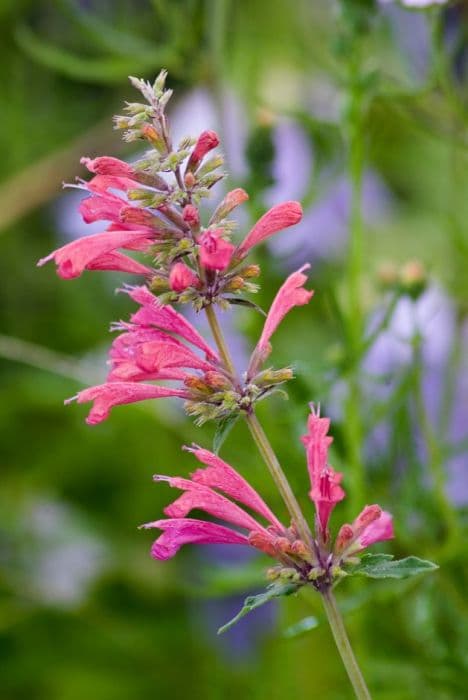Bugleweed Ajuga reptans f. albiflora 'Silver Shadow'

ABOUT
The Ajuga reptans f. albiflora 'Silver Shadow', commonly known as Bugleweed or Carpet Bugle, is a striking perennial ground cover featuring decorative foliage and flowers. The leaves of this cultivar are unique, presenting a shimmering silvery-white coloring, often edged or patterned with green veins, which creates a striking contrast and adds a vivid touch to shady garden areas. The foliage tends to form dense, spreading mats that effectively suppress weeds. In terms of flowers, the Bugleweed produces spikes adorned with small, hood-like blooms that emerge in a remarkable shade of blue, contributing to the plant's overall ornamental appeal. These flowers tend to rise slightly above the foliage in cluster formations, adding vertical interest to its low-growing habit. The intriguing combination of the silver-frosted leaves and the rich blue flowers makes 'Silver Shadow' a popular choice for gardeners looking to enhance the visual impact of their landscape with foliage plants that also deliver a punch of floral color. It is especially prized for its ability to brighten up shady spots and integrate well with other shade-loving perennials or ground covers.
About this plant
 Names
NamesSynonyms
Carpet Bugle, Bugleherb, Bugleweed, Carpetweed, Common Bugle
Common names
Ajuga reptans f. albiflora 'Silver Shadow'.
 Toxicity
ToxicityTo humans
Bugleweed is not generally considered highly toxic to humans. However, some people may experience mild discomfort or an allergic reaction if they ingest the plant or handle it and then touch their face or mouth. There is limited information available about the specific cultivar 'Silver Shadow', but in general, if symptoms do occur upon ingestion, they might include gastrointestinal upset such as nausea, vomiting, or diarrhea. Care should be taken to avoid ingestion and to wash hands after handling the plant, especially for those with sensitive skin or known allergies.
To pets
Bugleweed is also not generally considered highly toxic to pets, but as with humans, individual pets may have sensitivities or allergic reactions to it. If a pet ingests bugleweed, they may exhibit mild gastrointestinal upset, such as vomiting or diarrhea. It's always best to prevent pets from eating plants and to consult with a veterinarian if any unusual symptoms occur following ingestion. While not typically life-threatening, monitoring your pet for any discomfort or adverse reactions is recommended.
 Characteristics
CharacteristicsLife cycle
Perennials
Foliage type
Evergreen
Color of leaves
Variegated
Flower color
Blue
Height
0.5 feet (15 cm)
Spread
1 foot (30 cm)
Plant type
Creeper
Hardiness zones
3-9
Native area
Europe
Benefits
 General Benefits
General Benefits- Low Maintenance: Ajuga reptans, commonly known as Bugleweed, is easy to care for and requires minimal upkeep.
- Ground Cover: Its spreading habit makes it an excellent ground cover, able to fill in spaces and suppress weeds.
- Drought Tolerance: Once established, Bugleweed has good drought tolerance, making it suitable for drier climates.
- Erosion Control: Its dense matting can help prevent soil erosion on slopes and banks.
- Aesthetic Appeal: The 'Silver Shadow' variety offers attractive silver-edged foliage that provides visual interest.
- Pest Resistance: Bugleweed is generally resistant to pests and diseases, reducing the need for chemical treatments.
- Attracts Pollinators: The flowers of Bugleweed attract bees and butterflies, beneficial for pollination in gardens.
- Seasonal Interest: Provides flowers in late spring to early summer, adding seasonal color to the garden.
- Shade Tolerance: Bugleweed can thrive in shady areas where many other plants struggle to grow.
 Medical Properties
Medical Properties- This plant is not used for medical purposes.
 Air-purifying Qualities
Air-purifying QualitiesThis plant is not specifically known for air purifying qualities.
 Other Uses
Other Uses- Groundcover for shaded areas: Ajuga, also known as bugleweed, with its dense foliage, can be used to cover bare spots in shady parts of gardens.
- Container gardening: 'Silver Shadow' can be grown in containers for patios or balcony gardens, where its variegated leaves add visual interest.
- Bee and butterfly attraction: The flowers of Ajuga are known for attracting bees and butterflies, making it a beneficial addition to a pollinator garden.
- Accent plant: Due to its unique foliage, Ajuga 'Silver Shadow' can serve as an accent plant in a mixed flower border or garden bed.
- Erosion control: This plant is effective at controlling soil erosion on slopes or in areas where grass struggles to grow.
- Living mulch: Bugleweed can act as a living mulch, suppressing weeds and helping to retain soil moisture.
- Edging plant: Ajuga can be used as an attractive edging plant for walkways, paths, or garden borders.
- Green roof gardens: Due to its low maintenance and spreading habit, Ajuga is suitable for planting on green roofs.
- Crafting: The leaves and flowers can be used in floral crafts, such as wreaths or pressed flower arrangements.
- Seasonal interest: Ajuga 'Silver Shadow' provides seasonal interest with its spring blooms and year-round foliage, especially in temperate climates.
Interesting Facts
 Feng Shui
Feng ShuiBugleweed is not used in Feng Shui practice.
 Zodiac Sign Compitability
Zodiac Sign CompitabilityBugleweed is not used in astrology practice.
 Plant Symbolism
Plant Symbolism- Protection: Ajuga, also known as Bugleweed, has been historically used in folk medicine and believed to offer protective qualities against negative energies or forces.
- Perseverance: The aggressive growth habit and the ability of Bugleweed to thrive in difficult conditions can symbolize the ability to persevere through challenging circumstances.
- Healing: Due to its medicinal properties, Bugleweed is often associated with healing and the mending of physical or emotional wounds.
- Harmony: The ground-covering nature of Bugleweed reflects the idea of creating harmony and balance in one's surroundings, much like it creates a carpet of foliage in the garden.
 Water
WaterThe Bugleweed should be watered moderately, maintaining a balance without letting the soil become too dry or overly saturated. Generally, Bugleweed requires watering once a week, but this may vary depending on climate conditions and soil type. It is best to check the top inch of soil for dryness and water appropriately, aiming for about one gallon of water per plant each week during active growth periods. During the winter or in cooler climates, watering can be reduced. Ensure that water penetrates the soil deeply to encourage a strong root system, but take care to avoid waterlogging, as this can lead to root rot.
 Light
LightBugleweed prefers partial shade to full sun, thriving best when it receives morning sunlight and afternoon shade, especially in hotter climates. It can tolerate full sun in cooler regions with adequate moisture. The best spot for planting Bugleweed is an area that offers relief from the intense heat of the midday sun. This plant can adapt to different lighting conditions but will have the best growth and foliage color in locations with the right balance of light and shade.
 Temperature
TemperatureBugleweed is hardy and can withstand temperatures as low as -20 degrees Fahrenheit, making it a robust choice for various climates. The ideal temperature range for the Bugleweed is between 60 and 75 degrees Fahrenheit, which promotes vigorous growth and flowering. It can survive in temperatures up to about 85 degrees Fahrenheit, but prolonged exposure to heat can stress the plant if not properly shaded and watered.
 Pruning
PruningPruning the Bugleweed is primarily done to remove any spent flower spikes and to maintain a tidy appearance; it can also help prevent the spread of the plant if desired. The best time to prune is after flowering, typically in late spring or early summer. It is recommended to cut back the flower spikes and any undesirable growth once a year to promote denser foliage and to keep the plant from becoming invasive. Pruning can also help rejuvenate an older plant and encourage more vibrant growth.
 Cleaning
CleaningAs needed
 Soil
SoilThe Carpet Bugle 'Silver Shadow' thrives in well-draining soil enriched with organic matter, with a pH range of 6.0 to 7.5. A mix of garden soil, compost, and peat or pine bark can provide the ideal structure and nutrient balance.
 Repotting
RepottingCarpet Bugle 'Silver Shadow' typically does not require frequent repotting; it can be repotted every 2-3 years or when it outgrows its container.
 Humidity & Misting
Humidity & MistingCarpet Bugle 'Silver Shadow' fares well in average humidity levels and does not require any special humidity adjustments.
 Suitable locations
Suitable locationsIndoor
Place in medium light and water when topsoil is dry.
Outdoor
Plant in partial shade, water regularly, and mulch.
Hardiness zone
3-9 USDA
 Life cycle
Life cycleThe perennial known as Bugleweed 'Silver Shadow' begins its life cycle when the seeds germinate, usually in spring, in moist, well-draining soil under partial shade. After germination, the seedlings establish a rosette of leaves at the soil surface. As the plant matures, it produces patches of foliage with its distinctive silver-edged leaves and starts spreading horizontally by sending out runners, or stolons, which root at nodes to form new plantlets. In late spring to early summer, 'Silver Shadow' sends up flower spikes with white blooms that are attractive to pollinators such as bees. After flowering, the plant sets seeds, which can disperse to propagate new plants. During winter, Bugleweed 'Silver Shadow' may die back, especially in colder climates, but it will regrow from the roots the following spring.
 Propogation
PropogationPropogation time
Spring to Summer
Carpet Bugle, or Ajuga reptans f. albiflora 'Silver Shadow', is typically propagated through division, a process best performed in either spring or fall. To propagate by division, dig up an established clump and gently separate the rooted sections into smaller pieces. Each division should have a portion of the root system and several shoots to ensure successful growth. Replant the divisions immediately at the same soil depth they were growing at previously, spacing them about 8 to 12 inches (20 to 30 centimeters) apart to allow room for growth. Water the new plantings thoroughly after transplanting to help establish the root system. The divisions will quickly take root and spread, covering the planting area with their attractive foliage and flowers.





![Bugle [Sugar Plum]](/_next/image?url=https%3A%2F%2Fplants-admin.emdemapps.com%2Fimages%2Fplants%2F%2Fimages%2F604b597956a55.png&w=640&q=75)
![Bugle [Princess Nadia]](/_next/image?url=https%3A%2F%2Fplants-admin.emdemapps.com%2Fimages%2Fplants%2F%2Fimages%2F604b5806e268c.png&w=640&q=75)


